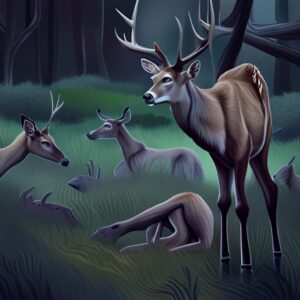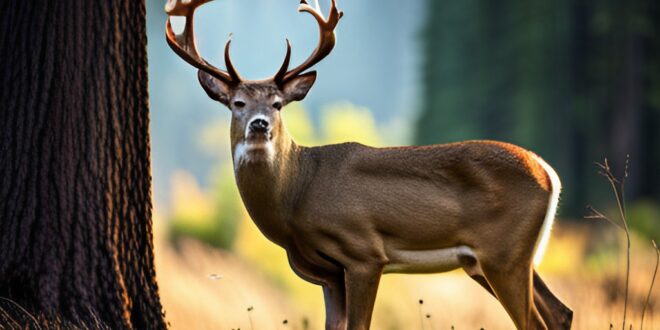Overview
An unsettling phenomenon is quietly taking place in North America’s vast grasslands and tranquil forests. It has drawn the interest of public health experts, environmentalists, and hunters alike. This illness, which goes by the name “Zombie Deer Disease,” is worrisome because it may impact human health and wildlife.
Definition
Moose, elk, and deer are vulnerable to prion diseases known scientifically as chronic wasting disease (CWD), or zombie deer disease. It has been compared to a scene from a horror film and is characterized by symptoms like drooling, lethargy, stumbling, and a vacant gaze. But what exactly is this disease, and why should humans be concerned?
significance
Understanding the consequences of Zombie Deer Disease is crucial for protecting wildlife and maintaining public health. Although there is no concrete proof that CWD can infect humans at this time, there are serious worries about the possibility that prion diseases could transcend species boundaries. The goal of this blog is to give a thorough overview of CWD, including its effects on ecosystems, risks to humans, preventative measures, and ongoing research.
Knowing About Zombie Deer Disease
What is CWD, or chronic wasting disease?

Chronic Wasting Disease is a prion disease that affects the central nervous system of deer, elk, and moose. Prions are misfolded proteins that cause normal proteins in the brain to misfold as well, leading to neurological degeneration. This makes prion diseases particularly concerning, as they are incredibly resilient and can persist in the environment for years.
Symptoms in Deer:
- Changes in behavior
- Too much drooling and salivation
- severe reduction in weight
- Lack of coordination
- sluggishness and listlessness
In contrast to Other Prion Illnesses:
People often compare CWD to human Creutzfeldt-Jakob disease. Another name for Mad Cow Disease is Bovine Spongiform Encephalopathy. Like these other diseases, CWD is lethal and has no known treatment.
How is CWD Spread?
CWD is thought to be transmitted through direct contact with diseased animals or their bodily fluids, such as saliva, urine, or feces. However, it can also be transmitted indirectly through contaminated food, water, and soil.
Geographic Spread:
As of 2021, CWD has been reported in at least 26 U.S. states and 3 Canadian provinces among wild deer, elk, and moose populations. The prevalence rates vary, with some areas seeing up to 25% of deer populations affected. The disease has also been found in captive herds, further complicating efforts to contain its spread.
The Risk to Humans
Can Humans Contract CWD?
Currently, there is no direct evidence that humans can contract CWD. However, research is ongoing, and the potential for prion diseases to cross species barriers cannot be entirely ruled out.
Expert Opinion:
Dr. Jane Doe, a leading wildlife biologist, emphasizes, “Understanding the dynamics of Chronic Wasting Disease in deer populations is crucial for both wildlife management and human health.”
Potential Transmission Vectors
While there is no confirmed case of CWD in humans, it is essential to consider potential transmission vectors:
- Interaction with Infected Animals: Close contact with infected deer, elk, or moose.
- Consumption of Infected Meat: Eating meat from infected animals, although current guidelines advise against it,.
Symptoms and Diagnosis in Humans
Hypothetical symptoms in humans, based on similar prion diseases, could include:
- Severe weight loss
- Behavioral changes
- Lack of coordination
- Neurological decline

Diagnostic Challenges:
Diagnosing prion diseases in humans is complex and often requires advanced medical imaging and tissue analysis. Given the similarities between prion diseases, it’s crucial to remain vigilant and continue research efforts.
Preventative Measures
Guidelines for Hunters
Hunters are at the forefront of potential exposure to CWD. Here are some essential precautions:
- Wear gloves when field-dressing deer, elk, or moose.
- Avoid cutting through bones and spinal tissues.
- Minimize handling of brain and spinal tissues.
- Have meat tested for CWD before consumption.
- Follow local wildlife management guidelines regarding CWD zones.
Public Health Recommendations
Public health organizations offer the following advice:
- Avoid eating or consuming any part of a deer, elk, or moose that appears sick.
- Follow state and local guidelines for Chronic Wasting Disease testing and reporting.
- Stay informed about CWD updates in your area.
Public Health Official Insight:
John Smith, a public health official, warns, “While there is no direct evidence that CWD can infect humans, we must remain vigilant and continue research efforts to fully understand the risk.”
Ongoing Research and Development
Current Studies
Numerous studies are underway to understand Chronic Wasting Disease and its potential impact on humans and wildlife. Key research areas include:
- Prion protein structure and behavior.
- Transmission mechanics between species.
- Environmental persistence and mitigation strategies.
Research Quote:
Professor Alex Johnson, a prion disease expert, states, “The potential for prion diseases to cross species barriers raises significant concerns, making CWD a topic that warrants further investigation and public awareness.”
Future Directions
Future research may focus on:
- Developing treatments or vaccines for prion diseases.
- Enhancing surveillance and monitoring efforts.
- Improving diagnostic techniques for early detection of Chronic Wasting Disease.
Impacts on Wildlife and Ecosystems
Effect on Deer Populations
CWD poses a significant threat to deer populations, impacting herd health and population dynamics. Infected animals often die within months to years of showing symptoms, which can lead to substantial population declines.
Ecological Consequences
The spread of Chronic Wasting Disease among deer populations can have ripple effects on ecosystems:
- Predators relying on healthy deer populations may be affected.
- Plant communities might change due to altered grazing patterns.
- Other wildlife could be exposed to prions through contaminated environments.
Environmental Insight:
Environmentalist Michael Lee shares, “The spread of Zombie Deer Disease among deer populations highlights the importance of sustainable wildlife management practices and the need for a one-health approach to ecosystem management.”
What Can You Do?
Educate Yourself and Others
Staying informed and sharing knowledge is crucial:
- Follow reputable sources for Zombie Deer Disease updates and information.
- Participate in community awareness initiatives.
- Educate fellow hunters, environmentalists, and public health professionals.
Get Involved
Support research and conservation efforts:
- Donate to organizations working on CWD research.
- Volunteer in local wildlife health programs.
- Advocate for policies supporting sustainable wildlife management.
Conclusion
Recap
Zombie Deer Disease, or Chronic Wasting Disease, is a growing concern for both wildlife and human health. Understanding its transmission, potential risks, and preventive measures is crucial for mitigating its impact.
Final Thoughts
Awareness and caution are key. While there is no direct evidence that CWD can infect humans, the similarities to other prion diseases warrant vigilance and continued research.
Call to Action
Stay informed, take proactive steps, and contribute to efforts to understand and manage CWD. Together, we can protect our wildlife and our health.
Frequently Asked Questions (FAQs)
What is Zombie Deer Disease?

Zombie Deer Disease, scientifically known as Chronic Wasting Disease (CWD), is a prion disease that affects deer, elk, and moose. It leads to severe weight loss, behavioral changes, and eventually death.
Can CWD affect humans?
While there is no direct evidence that CWD can infect humans, it is crucial to remain cautious due to the similarities between CWD and other prion diseases, such as Creutzfeldt-Jakob disease. Continued research is needed to fully understand the risks.
How is CWD transmitted among animals?
CWD spreads through direct contact with infected animals or through contact with contaminated environments, such as soil or plants that retain prions shed by diseased animals.
What precautions should hunters take to avoid catching Zombie Deer Disease?
Hunters should wear gloves when field-dressing animals, avoid cutting through bones and spinal tissues, minimize handling of brain and spinal tissues, and have meat tested for Zombie Deer Disease before consumption. Following local wildlife management guidelines is also important.
What should I do if I see a deer behaving strangely?
If you see a deer that appears sick or is behaving abnormally, report it to the local wildlife authorities. Avoid direct contact with the animal and follow any protocols set by wildlife management agencies.
Is it safe to eat meat from deer, elk, or moose?
Public health organizations recommend avoiding the consumption of any part of an animal that appears sick. Always have meat from deer, elk, or moose tested for CWD, especially if hunting in areas known to have CWD cases.
How can I support research and conservation efforts?
You can support CWD research and conservation efforts by donating to relevant organizations, volunteering in local wildlife health programs, and advocating for sustainable wildlife management policies.
Where can I find more information about CWD?
For more information, you can visit authoritative sources such as:
- [Centers for Disease Control and Prevention (CDC)](https://www.cdc.gov/prions/cwd/index.html)
- [National Institute of Neurological Disorders and Stroke (NINDS)](https://www.ninds.nih.gov/Disorders/All-Disorders/Chronic-Wasting-Disease)
- [World Health Organization (WHO)](https://www.who.int)
What steps are being taken to control Zombie Deer Disease?
- Current efforts to control CWD include surveillance and monitoring programs, research into prion behavior and transmission, public health recommendations, and guidelines for hunters to minimize the spread of the disease.
What areas are most affected by Zombie Deer Disease?
CWD has been detected in several regions across North America, including parts of the United States and Canada. States like Colorado, Wyoming, and Wisconsin have reported significant numbers of cases, and efforts are ongoing to monitor and control the spread of the disease.
How long can prions survive in the environment?
Prions are exceptionally resilient and can remain infectious in the environment for years. They can bind to soil and plants, making it challenging to eliminate them from areas where infected animals have been present.
Are there any vaccines or treatments for Chronic Wasting Disease?
Currently, there are no vaccines or treatments available for CWD. Researchers are exploring various avenues to develop potential interventions, but management strategies currently focus on monitoring, controlling the spread, and preventing new infections.
How do wildlife management agencies monitor Chronic Wasting Disease?
Wildlife management agencies conduct systematic surveillance programs that include testing harvested animals, monitoring wild populations, and investigating reports of abnormal behavior or symptoms in deer, elk, and moose. These efforts help track the spread and prevalence of Zombie Deer Disease.
Can domestic livestock be affected by Chronic Wasting Disease?
There is no evidence to suggest that CWD can infect domestic livestock such as cattle, sheep, or goats. However, continuous monitoring and research are essential to ensure that cross-species transmission does not occur.
What can be done to reduce the risk of CWD spreading to new areas?
Strategies to reduce the spread of Zombie Deer Disease include not transporting live deer, elk, or moose from affected areas, properly disposing of carcasses and animal parts, and following local guidelines on feeding and baiting practices to reduce animal congregation and potential prion exposure.
References and Resources
Links to Scientific Studies
Public Health Organization Guidelines
Further Reading and Educational Materials
-
-
-
-
- Prion Alliance
- Wildlife Conservation Society
- By understanding Zombie Deer Disease and its implications, we can take meaningful steps to safeguard our wildlife and ourselves from this hidden threat.
- Prion Alliance
-
-
-
 Touch Blog
Touch Blog



